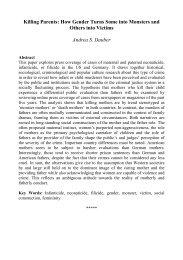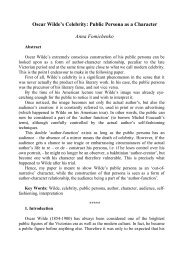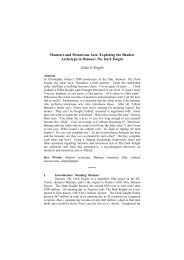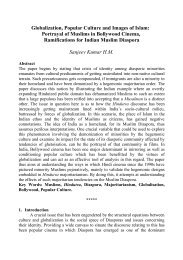“These three avant-garde designers have become an international ...
“These three avant-garde designers have become an international ...
“These three avant-garde designers have become an international ...
You also want an ePaper? Increase the reach of your titles
YUMPU automatically turns print PDFs into web optimized ePapers that Google loves.
Azzendine Alaïa, Je<strong>an</strong> Paul Gaultier, Vivienne Westwood, <strong>an</strong>d Helmut L<strong>an</strong>g. Notably on<br />
display was Yamamoto’s unconventional wedding dress in mother of pearl silk with a<br />
hoop skirt <strong>an</strong>d hidden pockets (Spring/Summer 1999). Five years later in 2006, Breaking<br />
the Mode: Contemporary Fashion from the Perm<strong>an</strong>ent Collection at the Los Angeles<br />
County Museum again displayed Yamamoto’s work with most of the same names. The<br />
garments curators Sharon S. Takeda <strong>an</strong>d Kaye D. Spilker chose to display showed<br />
Yamamoto’s revisions of traditional Western fashion elements including a tailored<br />
women’s two-piece suit in wool gabardine (Autumn/Winter 1993-1994) whose “in-<br />
progress” state—complete with “temporary” stitches—was thought to be radical. Also on<br />
display was a <strong>three</strong>-piece ensemble composed of trousers, a silk satin coat with a<br />
voluminous lace train, <strong>an</strong>d wide-brimmed straw hat (Spring/Summer 1999). The curators’<br />
choice of garments from Yamamoto’s Spring/Summer 1999 Collection, as done at the<br />
V&A, is signific<strong>an</strong>t as scholars <strong>have</strong> noted its break from his earlier designs to those<br />
referencing haute couture, defining radical in terms of traditional Western dress. 15<br />
A reviewer from Jardin des Modes, describing the 1982 collections of Yamamoto <strong>an</strong>d<br />
Kawakubo, stated, <strong>“These</strong> two collections are in absolute rupture with our Western<br />
vision.” 16 This statement—in view of the <strong>an</strong>ti-Jap<strong>an</strong>ese sentiment of the 1980s—conjures<br />
a new me<strong>an</strong>ing. Museums remained quiet during this decade during which Jap<strong>an</strong>ese<br />
control of U.S. industrial sectors was at its height. It is only in the late nineties that<br />
Yamamoto became a suitable exhibition subject. At this time, m<strong>an</strong>y shows built on the<br />
foundation made by Je<strong>an</strong> C. Hildreth in 1983, situating Yamamoto as a Jap<strong>an</strong>ese designer<br />
in a narrative of revolutionary, atypical dress in the broader history of fashion. 17<br />
Two displays coincided with A New Wave in Fashion: Three Jap<strong>an</strong>ese Designers: a<br />
6

















